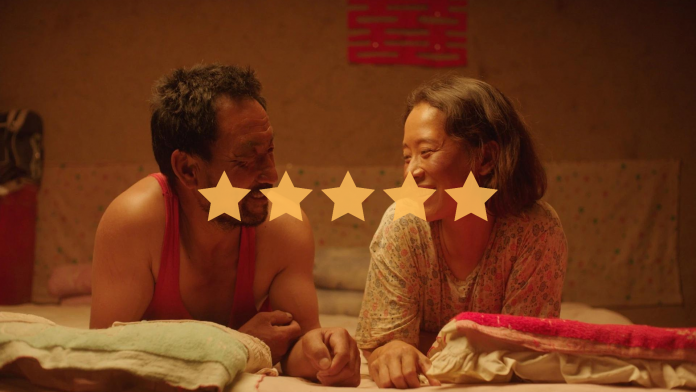★★★★★
Following the lives of Chinese farmers Youtie Ma and Guiying, Return to Dust explores rural life in the most populous country on earth. Enduring trauma, severe storms, exploitative elites and unfeeling government programmes, tragedy shapes their lives in ways that are beyond their control.
There is a scene in Return to Dust in which Guiying, a poor farmer in Gansu, China, accidentally uproots a wheat sapling whilst weeding a field. She holds it up to her husband, Youtie, visibly upset. To comfort her, he tells her that it will now serve as fertiliser for other crops. This, he says, is sometimes the destiny of things.
At its best, cinema can transport audiences to other places, allowing them to experience and feel other lives that they would otherwise never know. Return to Dust does just that. Encapsulated in that scene, the film explores the lives of Chinese farmers in Gansu province. It depicts their daily struggles and successes, relationships, local power dynamics and their hopes in intimate detail. It examines the lives of the poorest people in the largest country on the planet, exploring the political and psychological experiences that make up their human experiences, resulting in an up-close and tremendously moving film.
Return to Dust follows the lives of Youtie Ma, a farmer in Gansu province, and his wife Guiying, who suffers enduring trauma from her treatment by her family. Opening with their marriage, it follows their relationship as it steadily builds over time. The film weaves the central narrative with larger social questions. They are passive characters that by and large lack agency over their lives—their powerlessness is one of the film’s central themes. When the village landlord, upon whom the villagers rely to pay their land rents, falls ill and needs a blood transfusion, Youtie Ma is the only one with the appropriate blood type. Thereafter, he is frequently taken to a van to donate blood to keep the landlord, who is never seen in the film, alive. Youtie and Guiying are forced to move frequently as a government programme has old homes knocked down for renewal. Each time, they neither complain nor try to resist their eviction, but look on helplessly as their home is destroyed.
The film features many laconic characters – most notably, the two main characters. In the first few minutes, showing the prelude to their wedding, they do not speak to each other at all. Indeed, their relationship is initially extremely awkward, perfectly demonstrated in a single-shot in which their wedding photograph is being taken. It takes most of the film for them to begin to appear comfortable with each other. One of the film’s great strengths is that it allows their relationship to develop naturally and slowly. We note each gradual shift as the characters grow closer together, watching their relationship naturally develop as they experience personal successes and endure disastrous events.
The performances of the main actors carry the film. As Youtie Ma, Wu Ren Lin is compelling, rooting the film in his quiet, sombre yet compassionate character. His quiet yet resilient empathy and care for both his wife and the animals they care for, despite all the hardship they face, make him an almost tragic figure. Yet it is Hai Qing as his wife Guiying whose performance anchors the film. Her character is extremely vulnerable, physically and mentally, yet also she also manages to convey a core of strength. Largely a silent character, Hai Qing embodies her frailty and strength, her struggles and successes. She allows us to empathise without pitying, making her the emotional centre of the film.

Aside from a compelling and engaging story, the film is peppered with beautiful cinematography. The landscape of rural Gansu takes on a character in and of itself. The harshness of the landscape reinforces the hardships of rural life. In this hostile environment, Ma’s ability to persevere stands out all the more. Colour is used to great effect to accentuate the destitution and also vibrancy of rural life.
As often in stories about modern China, the significance of the individual in their wider community is a central theme. The main characters in Return to Dust are at the bottom of society. Poor, rural and stuck in the societal and geographical place they were born, they work to improve their lives. Stuck in a traditional way of life, they have few places to go and few chances to make changes for themselves. In the end, they are left to react to changes that occur around them and to make what they can out of their lot. Return to Dust tells the story of two such characters who struggle through their lives, creating what they can to improve their situation out of the hands they were dealt. It is a memorable and moving depiction of life in rural China—and of human resilience.
The Verdict
Return to Dust tells an extremely compelling story that transports its viewers into rural China. With complex characters portrayed with empathy, beautiful cinematography and a powerful story, it is a spectacular film. Its slower pace allows the viewer to become immersed in the lives of Youtie and Guiying and feel their daily struggles.
Words by Reuben Bharucha
This film was screened as part of the Edinburgh International Film Festival. You can find the rest of our coverage here.
Support The Indiependent
We’re trying to raise £200 a month to help cover our operational costs. This includes our ‘Writer of the Month’ awards, where we recognise the amazing work produced by our contributor team. If you’ve enjoyed reading our site, we’d really appreciate it if you could donate to The Indiependent. Whether you can give £1 or £10, you’d be making a huge difference to our small team.
